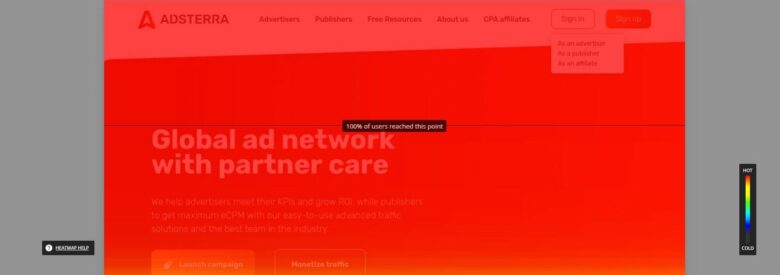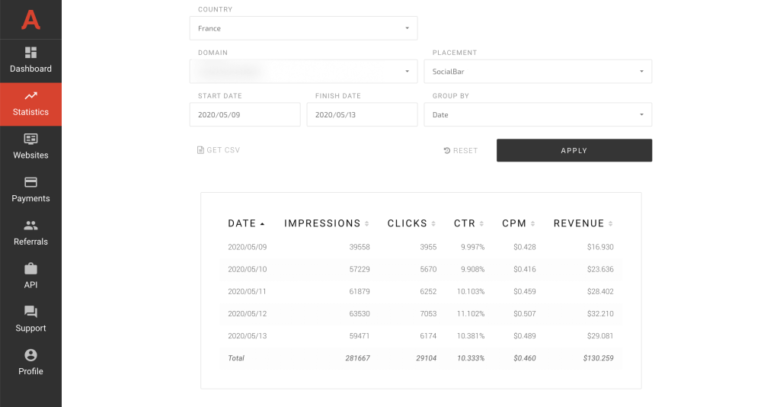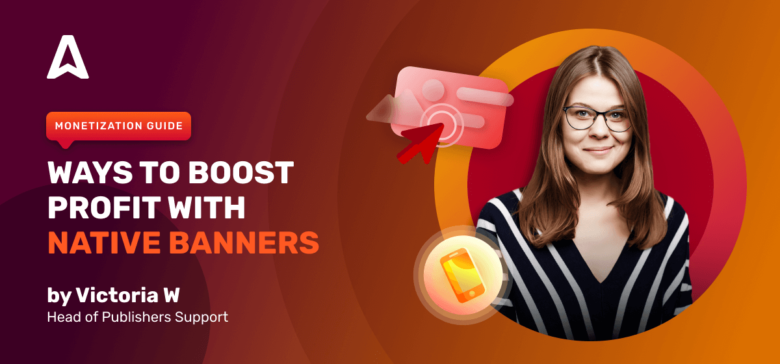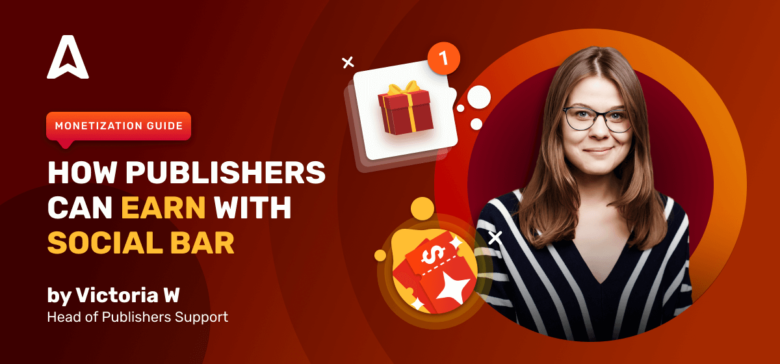While the efforts of some publishers pay off, while the revenues of others don’t seem to rock, making them ask “why is my CPM low?”. You may be surprised, but the majority of factors that slow down or even block publishers’ business growth can simply be defeated! And this will be the goal of this checklist post. We’ll overcome the main difficulties publishers face when running their business online and highlight critical website monetization mistakes.
We divided our checklist into two parts. The first one will cover major advertising mistakes (the way you get and place ad formats on the web pages). The second part is all about non-direct factors that can badly affect a website’s profitability.
12 critical website monetization mistakes
Let’s take a look at the common mistakes publishers make when placing advertisements on their websites. As we’re in the Adsterra blog, we will use some screenshots related to the platform, as well as giving examples of our ad formats. However, most of the points listed are fair for any advertising network.
1. Too many ads on a single page scare off your target audience
A common misconception among publishers is that “more ads” equals “more money.” That’s not true.
First of all, users are distracted by different messages and can’t choose between them. Here comes the banner blindness effect!
And second: earning from ad impressions is your goal, not your visitors’ 😉 Users come for a purpose, so your content must solve problems, answer questions, give instructions, and so on. If they don’t get the contend needed, they shift to other similar sites and hardly return.
💡 Avoid ad density and combile formats
You can place several banners on a single page, though. But please avoid ad density (multiple formats placed together).
It is worth to use different placements and sizes of banners, too. E.g., a 728x90px format comes above the content, that of 300x250px is for the sidebar, and one format left for the the footer part. Another example is when you place a couple of native banners’ sections in a long-form article.
There is an even better strategy. Combine ad formats that don’t look alike and interact with users in a different way:
- Popunders and banners
- Native ads and push ads
- Popunders and Social Bar
- Video ads and Native banners
2. Your blogposts are sliced with multiple native ads
Previously, we pointed that placing native banners on a single page is a good idea. But when you slice your blogposts or pages with multiple sets of native banners, you become too salesy. Even native formats can become annoying in this case.
In-article ads perform great when users meet them up to 3 times per post. Some websites — video streaming platforms and file storages — can act more aggressively, showing native banners almost on every part of the web page. It all depends on the website profile and your users’ sensitivity.
Are your native ads native enough? Learn where to place native banners and get one of the CPM-boosting ad formats by Adsterra!
3. You use too many ad formats simultaneously
While combining advertising formats is a sound and wise strategy, it still can lead to poor results. Why so? First, it’s because one can put all existing ad formats on the very same page. Users will feel under the attack of banners, push, video ads, and finally, get a couple of popunders greeting them in the new browser tabs.
Second, multiple ad formats make it harder for you to assess the productivity of each of them. You risk failing to identify the most efficient ones and miss the most irritating.
It’s best to start with a single format, then add another, analyze the results, and study your audience’s reaction to each separate ad unit.
With Adsterra Publishers Statistics, you manage all ad placements, for our system marks them all. Choose your domain from the list, pick the ad format you want to analyze, and check all key metrics one by one: clicks, CTR, CPM, revenue.
4. Not adapting the ad format to your website's niche and content
Except for the universal Smart Direct Link — a simple URL that you can put anywhere and earn from impressions — all other ad formats should match your content.
Supposing, when you’re running a web service platform (a File Converter), you can use almost any visual placements, from VAST video pre-rolls to popunders. But when we refer to sensitive content, like long-form articles, tutorials, how-tos, it is better to use the least intrusive formats. Native banners and Popunders will be the most suitable unit here.
5. Ad formats don't fit your traffic type
Along with advertising units that don’t fit your website niche and content, there can also be mismatches between the format and the traffic type. Let’s go over some examples.
Web push notifications
While more and more users get the opportunity to decline push notifications, ads based on users’ subscriptions will gradually fade.
Actually, classic push notifications are getting banned by Google Chrome more often each day, and they aren’t available on iOS devices.
At the same time, the new generation of in-page push ads work even with iOS, remaining AdBlock-friendly. So, if you’re focusing on iOS traffic, you can now shift to a more prominent format.
Mobile VS Desktop formats
Quite plain, but still making trouble: some publishers use desktop banner formats on mobile website versions. Make sure that banner size is OK for mobile screens. For instance, 798×90 px is a traditional desktop leaderboard, while 320×50 is a mobile leaderboard.
Pop-up and interstitial ads mechanics
Classic pop-ups and interstitials are pretty aggressive because they can block the web page content. If your visitors belong to Gen Z or are even younger, they will leave the website immediately. Pop-ups are not recommended for mobile traffic, as they act as a barrier between the website and the user.
As for interstitials, they’re more friendly (Google Ads Platform uses them widely!) but only when based on a dynamic iFrame technology. It allows users to click on the widget, collapse it or maximize the size while the website content remains usable. Interstitial ads by Adsterra come with the Social Bar format that uses the dynamic iFrame principle.
6. Incorrect frequency of popunder ads
Usually, the frequency of pop ads is set by default, but publishers can apply for changing it, aiming at showing ads as often as possible. That may lead both to CPM decrease and traffic loss. Numerous hidden tabs may discourage users from using your website next time.
With Adsterra, you get a balanced default frequency: 4 popunders in 2 hours with 10 seconds delay between them.
Increasing this frequency may result in CPM rates dropping, though your revenues will temporarily boost. But only temporarily. Advertisers who bid for your traffic will soon realize that their offers are all messed up with loads of other campaigns.
7. Wrong placement of ad units
We have already mentioned that slicing your content with ads won’t pay off well. But if you delicately put a banner or native format in the long scroll page footer, it could also return zero profits. The balance is everything! How to choose the best spots for ad units?
First off, it’s crucial to understand how ad impressions are calculated. For example, native banners must load not less than 51% on a user’s device. So make sure your users are ready to scroll the page until they meet a set of native banners.
The home page isn’t always the best place to place ads. For example, if you have a news website, people often quickly leave the home page for other inner pages, ignore the home page content, or go straight to the Latest posts category.
Check how your visitors scroll and use web pages, which spots are visible and which are ignored. Google Behavior reports show the most visited pages, while various Heatmap and Scrollmap tools will tell you all about user behavior on each page.

8. Two or more ad networks' scripts on your website lead to poor monetization
It’s best to focus on one advertising network at first. Not necessarily Adsterra, but it must be one platform to serve you ads. Two or more scripts from different ad networks may conflict, and this can affect your page speed.
Moreover, when you’re focused on one ad network, you get a clear picture of how it works, what types of offers it streams, which formats are top-choice for your traffic.
If you switch from one ad network to another, you start the process of adapting these new ads to your website all over again, and you end up wasting time and money.
9. You remove the ad network's script too early
Another website monetization mistake is to start checking the statistics immediately after placing ad codes, hoping to see the desired results. Passive income is indeed instant, but the results depend on your traffic volume, the ad location, and users’ behavior.
In addition, ad networks can use AI algorithms of traffic-2-ads matching (Adsterra does). These algorithms scan your website first to select advertising offers that match your website traffic best. Sometimes it takes up to 48 hours to calibrate CPMs and adapt offers to your traffic.
10. Incorrect usage of ad codes/scripts
Sometimes, publishers make some adjustments to the scripts they got from the ad network. When copied incorrectly, scripts fail to serve any ads, which leads to zero CPM. When placed in the wrong part of the HTML code, they begin to conflict with the webpage’s settings.
One more common website monetization mistake is using the script twice. Each script is unique, and if you copy and paste it several times, statistics can double, triple, or even fail to deliver any data. You will not get any information about how the format works, whether it is visible and usable, how profitable it is, etc. The same is fair for several websites; you shall not move ad scripts between different domains.
This mistake is easier to avoid rather than fix. On the Adsterra platform, each ad format is followed back with instructions. Please read them attentively and place ad units precisely as recommended. For example, you can’t place native ads between the “<head>” tags, while popunders should be put exactly before the closing “</head>” tag.

11. Not trying AdBlock-friendly, new formats
Good all classics like banners or popunders (which is better for you?) is a sure-fire way of website monetization. But the advertising market is evolving, and you are missing some fantastic ways of making money. Like TikTok reshaped the social media landscape, Social Bar push ads are winning more and more views and…advertising budgets!
Neat, lovely designs fit almost any web page, whether it is a blog or file hosting.
For those publishers streaming mobile iOS traffic Social Bar is a must, for it is UX- and AdBlock-friendly.
Learn how to make a profit with the next-gen ad format for publishers. Social Bar spices up your CPM!
12. You ignore the website's metrics except for CPMs
Publishers often care about the CPM rate ignoring other metrics such as CTR and clicks.
Meanwhile, advertisers are those who set requirements to the sort of traffic they want to get and use CTRs as the measure of success.
What could be general reasons for the drop in CPM? A lot, actually.
For example, proxy traffic is much cheaper since it’s impossible to determine whether the user is unique or not and from what GEO they are from.
Desktop traffic is often cheaper than mobile traffic. Traditionally, traffic from Tier 3 countries is a lot cheaper than traffic from the USA, the UK, Australia, or Tier 2 countries. But not always. South African users are evaluated almost as highly as the Tier-1 audience.
Publishers can group all traffic they deliver by country and check how each GEO performs. They can also monitor the volume of clicks generated by each ad placement. It happens too often when a simple switch of ad placement location can improve CTRs and Clicks metrics and eventually amp CPMs.

Pre-summary
These were the saddest mistakes of website monetization that every publisher can make. Nothing fatal, as you can see. You can fix any of those pitfalls on your own or ask for our managers’ help. We have a bunch of indirect difficulties that can block your opportunities to grow income. Shall we list them now?
Indirect mistakes that block website monetization efforts
1. You create a website not for the people but for search engine algorithms
What did you create your website for? Most likely, you’ll say “to make money.” And that’s natural!
But will you be able to earn money if users will immediately leave your website and then stop coming altogether? The answer is obvious. Without traffic, you won’t achieve anything. So, what should you do?
Create a website for organic human traffic, for real people with real needs. And by that, we mean:
Post super-valuable and super-useful quality content on your website
Add value to trending topics, answer questions, provide useful tools and services. Your content will not necessarily be analytical articles or reviews. It can be file storage or an MP3 collection with an open license.
And people will come; they’ll eagerly wait for your next post, write reviews and comments, share your content, and recommend your services to their friends and peers.
2. Non-focusing on target group/groups of users
Like we said earlier, quality content is rewarded both by users and search engines. But it only works if there is demand for your content. Otherwise, you will supply premium content to nobody and gain nothing. It would help if you always stayed in the market.
Marc Andreessen wrote The only thing that matters for THE PMARCA GUIDE TO STARTUPS. In it, he states:
“The only thing that matters is getting to product/market fit. Product/market fit means being in a good market with a product that can satisfy that market.
You can always feel when product/market fit isn’t happening. The customers aren’t quite getting value out of the product, word of mouth isn’t spreading, usage isn’t growing that fast.”
Whatever the topic of your website, it has a specific target audience. If you haven’t identified it yet, then doing exactly that needs to become a priority. The more accurately you pinpoint your TA, the faster and the more you can monetize your website.
3. Driving fake or bot traffic or purchasing cheap, non-target traffic
Don’t neglect the quality of your traffic. You cannot monetize fake or bot traffic. Chasing cheap traffic will always result in unnecessary expenses. Keep in mind that all advertisers that stream ads on your website can identify you and assess how resultative their campaigns are on your traffic. If they detect a sudden sore in traffic that doesn’t bring them clicks or conversions, they will blacklist your website. Also, many advertisers are not interested in paying for proxy traffic as they don’t want to buy a pig in the poke.
Advertisers can target by keywords; that’s why it is vital to attract organic quality traffic.
4. Your hosting provider fails to deliver good performance
Remember, 40% of users will leave if your website doesn’t load within 3 seconds, so it’s essential to choose the right hosting.
The hosting provider must be reliable, fast, with good tech support. Some publishers start their online business with free or very cheap shared hosting. They’re great for beginners. But as your traffic volumes begin to grow, you will need a more powerful platform. Earlier, we shared a guide on how to choose a hosting service.
5. Not using other ways of traffic monetization
Websites are still the backbone of monetization strategy. But think bigger! You don’t need a multi-page website to drive, say, Facebook traffic to a simple landing page with ad codes. Just the same, TikTok, Pinterest, and Instagram monetization is also feasible.
Email marketing is irreplaceable for publishers, and you can start building your new source of income from loyal subscribers. Think of some extra value you can provide. Coupons from your partners, infographics, free trials, discounts? Use referral links to send as much traffic to your partners’ websites and get a commission from each target action.
Traditional affiliate marketing is still on top when it comes to getting profit from recommending goods and services. You won’t monetize instantly, like in the case with ad networks, and this way of making money requires lots of effort and time. But you definitely can get a solid commission when someone buys a product you recommended.
Summary: Grow your digital business with professionals
To make your digital strategy clear and avoid website monetization mistakes, start with a reputable ad network that partners with multiple advertisers. The ad network’s reputation will pay you additional money when you recommend it to your friends and make money from referrals.
Check whether you can earn on desktop users, mobile traffic, and profit from social traffic, like Facebook, Pinterest, Instagram, and TikTok users.
Make sure you can enrich your monetization tools with various ad formats, not only pops and banners.
And keep in mind that attitude and trust remain vital factors in any partnership. Choose trustworthy advertising networks with live support and educational materials. And stay safe from all website monetization mistakes.


